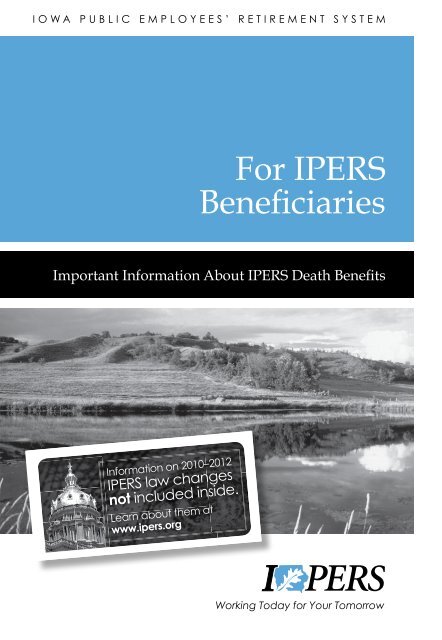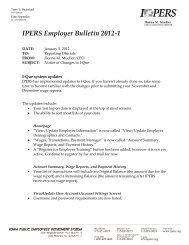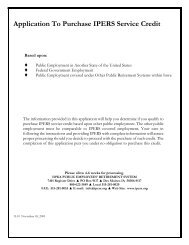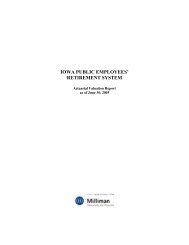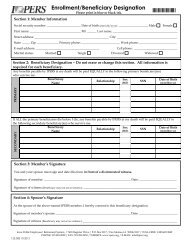For IPERS Beneficiaries
For IPERS Beneficiaries
For IPERS Beneficiaries
- No tags were found...
Create successful ePaper yourself
Turn your PDF publications into a flip-book with our unique Google optimized e-Paper software.
IOWA PUBLIC EMPLOYEES’ RETIREMENT SYSTEM<strong>For</strong> <strong>IPERS</strong><strong>Beneficiaries</strong>Important Information About <strong>IPERS</strong> Death BenefitsInformation on 2010–2012<strong>IPERS</strong> law changesnot included inside.Learn about them atwww.ipers.orgWorking Today for Your Tomorrow
<strong>IPERS</strong> provides financialprotection to members’beneficiaries. As abeneficiary, it’s importantthat you understand how<strong>IPERS</strong> death benefits workand what you need to doto begin receiving benefits.This brochure is designedto provide you with theinformation you need tomake this difficult situationa little easier.Photo courtesy of the Iowa Tourism OfficeThe Loess Hills in western Iowa are anatural formation of windblown hillswith unique flora. The only othernatural formation of windblown hillswith these depths exists in China.WHAT’S INSIDEPAGEFinancial Protection for Peace of Mind 2Who Are <strong>IPERS</strong> Members? 2Eligibility for Death Benefits 2If an <strong>IPERS</strong> Member Dies Before Retirement—Preretirement Death BenefitsIf an <strong>IPERS</strong> Member Dies After Retirement—Postretirement Death Benefits46Applying for Death Benefits 10Information About <strong>IPERS</strong> Death Benefits1
Financial Protection for Peace of Mind<strong>IPERS</strong> death benefits provide financial protection to eligiblebeneficiaries. They are designed to ease the financial strain thatsometimes follows the death of a loved one. You should notify<strong>IPERS</strong> as soon as possible after a member’s death. Notifying<strong>IPERS</strong> will help ensure that benefits are paid properly and timely.Benefits will be paid according to the most current beneficiarydesignation on file with <strong>IPERS</strong>.WHO ARE <strong>IPERS</strong> MEMBERS?<strong>IPERS</strong> covers most public employees in Iowa. Covered employersinclude—but are not limited to—schools, counties, state agencies,cities, and townships. If you think a loved one worked in <strong>IPERS</strong>coveredemployment at some point, please call <strong>IPERS</strong> to find outif you are eligible for death benefits.Eligibility for Death BenefitsThe <strong>IPERS</strong> beneficiary designation will supersede manylegal documents such as wills or assignments. A beneficiarydesignation generally will be revoked by a divorce decree,unless the beneficiary designation is implemented by a QualifiedDomestic Relations Order (QDRO). If a member has a QDRO onfile with <strong>IPERS</strong> that requires death benefits to be divided, deathbenefits will be paid according to the QDRO. (See the brochure“Divorce and <strong>IPERS</strong> Benefits” for more information about QDROs.)If there is no valid beneficiary designation on file, benefits will bepaid in the following order to the member’s:1. Estate; or if none,4. Parents; or if none,2. Spouse; or if none,5. Siblings (divided equally).3. Child(ren) (divided equally);or if none,If you are both an <strong>IPERS</strong> member and a beneficiary, you mayreceive <strong>IPERS</strong> pension and death benefits at the same time.2 <strong>For</strong> <strong>IPERS</strong> <strong>Beneficiaries</strong>
Payments to MinorsIf the designated beneficiary is a minor, death benefits must bepaid to a custodian or conservator. If the death benefit amount is:• Less than $25,000, payment may be made to theminor’s adult custodian.• $25,000 or more, the benefit must be paid to acourt-established conservator.If the minor will reach age 18 before the filing deadline, the minormay wait until he or she reaches age 18 to apply for benefits. Besure to contact <strong>IPERS</strong> as soon as possible to ensure that benefitsare claimed within the required time period to avoid forfeiture ofdeath benefits.When to File a ClaimClaims for death benefits should be filed as soon as possible afterthe member’s death. The required filing date is set by the IRS andmay vary according to your situation. If a claim for death benefitsis not made by the required filing date, death benefits may beforfeited. If there is more than one designated beneficiary andsome beneficiaries apply for death benefits within the requiredtimeframe and others do not, any unclaimed benefits will be paidpro rata to those who filed timely claims. Contact <strong>IPERS</strong> to findout your required filing date.Contact <strong>IPERS</strong> as Soonas Possible After aMember’s Death<strong>Beneficiaries</strong> should contact <strong>IPERS</strong>as soon as possible after a member’sdeath. If an application is not filedby the required filing date, benefitsmay be forfeited.Information About <strong>IPERS</strong> Death Benefits3
If an <strong>IPERS</strong> Member Dies Before Retirement—Preretirement Death Benefits<strong>IPERS</strong> provides death benefits if a member dies before beginningto receive <strong>IPERS</strong> retirement benefits. How <strong>IPERS</strong> pays out thebenefits depends on the beneficiary(ies) and the member’s vestedstatus.• If the member was not vested: Regardless of the number ortype of beneficiary(ies) designated, death benefits will be paidas a lump-sum payment.• If the member was vested: If there is only one individualdesignated as the beneficiary, the beneficiary may choosebetween a lump-sum payment or a lifetime monthly benefit(provided the monthly benefit is $50 or more). Otherwise,benefits will be paid as a lump-sum payment.An <strong>IPERS</strong> member is vested when the member has completed4 years of service or the member is working and makingcontributions to <strong>IPERS</strong> at age 55, whichever occurs sooner.Example 1Preretirement Death Benefit(Member With 15.25 Years of Service)After working for an <strong>IPERS</strong>-covered employer for 15.25 years,Bill dies at age 42. At the time of his death, his highest 3-yearaverage salary is $45,635. Bill’s lump-sum preretirementdeath benefit would be $46,744.4 <strong>For</strong> <strong>IPERS</strong> <strong>Beneficiaries</strong>
Example 2Preretirement Death Benefit(Member With 21 Years of Service)After working for an <strong>IPERS</strong>-covered employer for 21 years,Jane dies at age 59. At the time of her death, her highest 3-yearaverage salary is $42,000. Jane’s lump-sum preretirement deathbenefit would be $147,000.<strong>For</strong> more information about how death benefits are calculated,contact <strong>IPERS</strong>.Line-of-Duty Death BenefitSome <strong>IPERS</strong> members are considered“Special Service.” Special Servicemembers include sheriffs, deputysheriffs, and many other protectionoccupations. If a Special Servicemember’s death is the direct result ofa personal injury incurred in the lineof duty, a line-of-duty death benefitof up to $100,000 may be payable.The line-of-duty benefit will be paidas a lump sum and is in addition toany other death benefits that arepayable (not to exceed the InternalRevenue Code maximum). If youare a beneficiary of a Special Servicemember, please contact <strong>IPERS</strong> to seeif you are eligible.Information About <strong>IPERS</strong> Death Benefits5
If an <strong>IPERS</strong> Member Dies After Retirement—PostRetirement Death BenefitsIf a member dies after retirement payments begin, death benefitswill be based on the member’s payment election at retirement.<strong>IPERS</strong> offers six option choices as highlighted below.If the Member’sRetirement BenefitWas Paid as an…Option 1:Annuity WithFixed Lump-SumSurvivor BenefitThe Beneficiary Benefits Are…A lump-sum payment based on the amountelected by the member. The death benefitcannot exceed the amount of the member’stotal contributions plus interest.Option 2:Annuity With VariableDecreasingLump SumOption 3:Single Life AnnuityA lump-sum payment equal to the member’scontributions plus interest minus the totalretirement benefits the member receivedbefore his or her death.No death benefit is payable.Option 4:100%, 75%, 50%, or25% Joint andSurvivor AnnuityA monthly benefit for the remainder of thebeneficiary’s life in the amount of 100%,75%, 50%, or 25% (based on the member’selection) of the monthly benefit the memberwas receiving before his or her death.6 <strong>For</strong> <strong>IPERS</strong> <strong>Beneficiaries</strong>
ExampleJoe retires 2 months before his 59th birthday after working in <strong>IPERS</strong>coveredemployment for 21 years and earning a high 3-year averagesalary of $42,014.26. His wife is age 60 and 10 months. His <strong>IPERS</strong>contributions plus interest total $44,563.91. Here’s the amount of hisbenefit and the death benefit payable to his wife under each option.Monthly Benefit Payable to Joe: $1,331.76Minimum Lump-Sum Benefit Payable to Joe’s Wife in the Eventof His Death: $1,000Maximum Lump-Sum Benefit Payable to Joe’s Wife in the Eventof His Death: $44,000 (Joe’s monthly benefit would be $1,249.20.)Monthly Benefit Payable to Joe: $1,330.80Benefit Payable to Joe’s Wife in the Event of His Death:$12,624.71 after 2 years. After Joe receives 34 monthly payments,there will not be any death benefit payable to his wife.Monthly Benefit Payable to Joe: $1,333.68Benefit Payable to Joe’s Wife in the Event of His Death: NoneMonthly Benefit Payable to Joe:100% 75% 50% 25%$1,174.50 $1,210.62 $1,249.04 $1,289.97Monthly Benefit Payable to Joe’s Wife in the Event of His Death:100% 75% 50% 25%$1,174.50 $907.96 $624.52 $322.49Information About <strong>IPERS</strong> Death Benefits7
If the Member’sRetirement BenefitWas Paid as an…Option 5:120-Month TermCertain AnnuityOption 6:100%, 75%, 50%,or 25% Joint andSurvivor AnnuityWith Pop-UpAnnuityThe Beneficiary Benefits Are…If the member dies before receiving120 payments, the beneficiary will beeligible for a benefit. If the member alreadyreceived 120 or more payments at thetime of death, no payments will be madeto a beneficiary.If the beneficiary is an individual, thebeneficiary will receive a monthly benefitfor 120 months minus the number ofpayments the member received.If the beneficiary is several individuals, atrust, or an estate, payments will be madeas a lump sum.A monthly benefit for the remainder ofthe beneficiary’s life in the amount of100%, 75%, 50%, or 25% (based on themember’s election) of the monthly benefitthe member was receiving before his orher death.Please Note: Special Service members (sheriffs, deputy sheriffs, and manyother protection occupations) have an additional payment option available thatis not described above. Contact <strong>IPERS</strong> for more information.8 <strong>For</strong> <strong>IPERS</strong> <strong>Beneficiaries</strong>
ExampleJoe retires 2 months before his 59th birthday after working in <strong>IPERS</strong>coveredemployment for 21 years and earning a high 3-year averagesalary of $42,014.26. His wife is age 60 and 10 months. His <strong>IPERS</strong>contributions plus interest total $44,563.91. Here’s the amount of hisbenefit and the death benefit payable to his wife under each option.Monthly Benefit Payable to Joe: $1,301.79Monthly Benefit Payable to Joe’s Wife in the Event of HisDeath After 24 Months: $1,301.79 for 96 months; thereafter,no benefits payable.ORAssuming Joe had multiple beneficiaries, the lump sum payableif Joe dies after 24 months of pension payments is $97,600.52.Monthly Benefit Payable to Joe:100% 75% 50% 25%$1,157.91 $1,197.43 $1,239.75 $1,285.16Monthly Benefit Payable to Joe’s Wife in theEvent of His Death:100% 75% 50% 25%$1,157.91 $898.07 $619.87 $321.29Information About <strong>IPERS</strong> Death Benefits9
Applying forDeath BenefitsTo receive any deathbenefits you may beeligible for, you mustfile an applicationwith <strong>IPERS</strong> andcomplete the necessarysupporting paperwork.<strong>Beneficiaries</strong> shouldcontact <strong>IPERS</strong> as soon as possible after a member’s death. Benefitsmust be paid by the required filing date; otherwise, benefits may beforfeited. In the event of a member’s death, you should:• Contact <strong>IPERS</strong> as soon as possible.• Complete an application for benefits.• Submit the completed application and supportingdocumentation as soon as possible.Rolling Over BenefitsIf you are a surviving spouse and elect to receive your benefits asa lump sum, you may be eligible to roll over your death benefitinto another qualified retirement plan. If you are a beneficiarybut not a surviving spouse, you may be eligible to roll over yourdeath benefit to an IRA.Maximum Death BenefitsThe amount of death benefits a beneficiary is eligible to receivemay be limited. <strong>For</strong> example, according to the Internal RevenueCode, preretirement lump-sum death benefits for a 401(a) plancannot exceed 100 times the expected monthly payout themember would have received under Option 2 if the memberreached normal retirement age (generally age 65 or age 62, basedon years of service) at the time of his or her death. Line-of-dutydeath benefits may be reduced to comply with this requirement.10 <strong>For</strong> <strong>IPERS</strong> <strong>Beneficiaries</strong>
Stopping Monthly Benefits for RetireesIf a member dies while receiving monthly retirement benefits,the monthly payments stop the month following the member’sdeath (for example, if a member dies in July, the last monthlypension payment will be made in July). If any additionalretirement benefit payments are made after the month of themember’s death, these payments must be returned to <strong>IPERS</strong>.Tax InformationAs a beneficiary, there is tax information you should be awareof if you are receiving or will receive death benefits.You may receive one or more IRS <strong>For</strong>m 1099Rs from <strong>IPERS</strong> inthe year of the member’s death. If <strong>IPERS</strong> benefits are payable, one1099R will be in the beneficiary’s name. You may receive other1099Rs in the member’s name depending on your relationship tothe member. You will receive one 1099R in each following year ifyou receive death benefits as a monthly payment.ImportantThis booklet briefly explains certain rights and benefits of <strong>IPERS</strong>membership. It is not a substitute for federal and state lawsgoverning <strong>IPERS</strong>, which provide complete information and aresubject to change. Although <strong>IPERS</strong> makes every attempt to ensureits materials are accurate and up to date, any conflict between thecontents of the booklet and law must be resolved in favor of thelaw. The Member Handbook provides a more detailed descriptionof <strong>IPERS</strong> benefits. It is available electronically on the <strong>IPERS</strong> Website or in print by contacting <strong>IPERS</strong>.Information About <strong>IPERS</strong> Death Benefits11
Contact UsWe’re here to help you! If you have questions about <strong>IPERS</strong>,please don’t hesitate to contact us.By mailP.O. Box 9117Des Moines, IA 50306-9117In person7401 Register DriveDes Moines, IA 503218 a.m.–4:30 p.m., Monday–FridayPhone515-281-0020 or toll-free 1-800-622-38497:30 a.m.–5 p.m., Monday–FridayFax515-281-0053E-mailinfo@ipers.orgWeb sitewww.ipers.orgPlease contact <strong>IPERS</strong> to request an alternative format of thispublication. Additional brochures are available on our Web siteor upon request.12 <strong>For</strong> <strong>IPERS</strong> <strong>Beneficiaries</strong>
416.002 7/08©2008 Iowa Public Employees’ Retirement System


